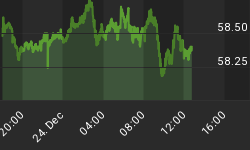After Wednesday's close, the Chicago Mercantile Exchange announced that they were raising the margin requirement for gold by 27%. This means the collateral they need to hold from traders buying on margin (borrowed money) jumped by 27% in a day. This is basically an attempt to break the back of gold. Central bankers do not like to see gold rising in a rapid fashion since it draws attention to their inflation-inducing and currency-debasing printing presses. Is it just a coincidence that the margin requirement was raised two days before Chairman Bernanke's Jackson Hole remarks? It's difficult to say "commodity prices havecome down" when the chart of gold is rising in a vertical manner.
Since significant gains can evaporate quickly in markets heavily dependent on printed money, we booked our profits in gold (GLD) on Wednesday. We also sold our remaining stake in silver (SLV). While it may not feel that way given the last two days, gold is still up significantly off the summer 2010 lows.

Gold and silver may both go on to make new highs, but their current risk-reward profile is much less attractive following gold's recent vertical ascent. We are very open to re-entering gold when a more attractive risk-reward profile is in place. While it has also been hit hard in the last two trading days, silver was still a better place to be than stocks over the last three weeks.

Given the Fed wants to avoid deflation, especially in the form of falling asset prices, the two-day sell-off in gold and silver does not give a lot of confidence in the market's expectation for inflationary/bullish outcomes following the Fed's Jackson Hole speech this Friday. Silver was the biggest winner after last year's inflation-inducing QE2 remarks from Jackson Hole. As noted on August 18, traders do not seem to be expecting a repeat performance of the 2010 post-Jackson Hole market.
The chart below shows the current gold/silver ratio (GLD/SLV). Silver tends to outperform gold during economic expansions and periods of positive inflation. Gold tends to outperform silver when fears of economic weakness and/or deflation move to the forefront. Notice the gold/silver ratio moved back above its 200-day moving average on Wednesday - the ratio is also close to a bullish crossover, as the 50-day approaches the 200-day (see chart below). These are deflationary, and possibly bearish, developments for asset prices. Given the change in margin requirements for gold, we do not want to read too much into any short-term analysis in the precious metals market, but the balance between downside risk and upside potential remains a little uncomfortable.

In the context of the last bear market, the move above the 200-day moving average that is shown above may not be a good sign for stocks, gold, or silver over the next few months (see next four charts).



In 2008, gold did recover and make a higher high, which is obviously possible in the coming weeks.


We are open to revisiting stocks if, and only if, we see something more than a snap-back rally. Our August 25 post identified another in a long series of concerning bearish developments for stocks. Volume on both the NYSE and NASDAQ was lower on Wednesday vs. Tuesday, indicating the big players were not participating as enthusiastically as individuals. Stock market breadth was positive, but far from great (not really aligned with the gains on Wednesday). It would not be surprising to see hedge funds short this rally in the coming days, especially if the S&P 500 gets back to the 1,200 to 1,260 range, which would not be out of character for a countertrend rally in a bear market.
Given what we know today, the current rally in stocks may be nothing more than a standard bear market bounce. If the Fed disappoints on Friday and stocks can hold their own, it may mean the economy is in better shape than what the markets have priced in (a bullish sign). Regardless of what is said at Jackson Hole, the market's reaction will help us. The bias remains to the downside, but the bulls have made some short-term progress in the form of stabilization. We need more information before deciding if we like the long or short side of these markets. We have a neutral stance with cash and a relatively small allocation to bonds (TLT).
















